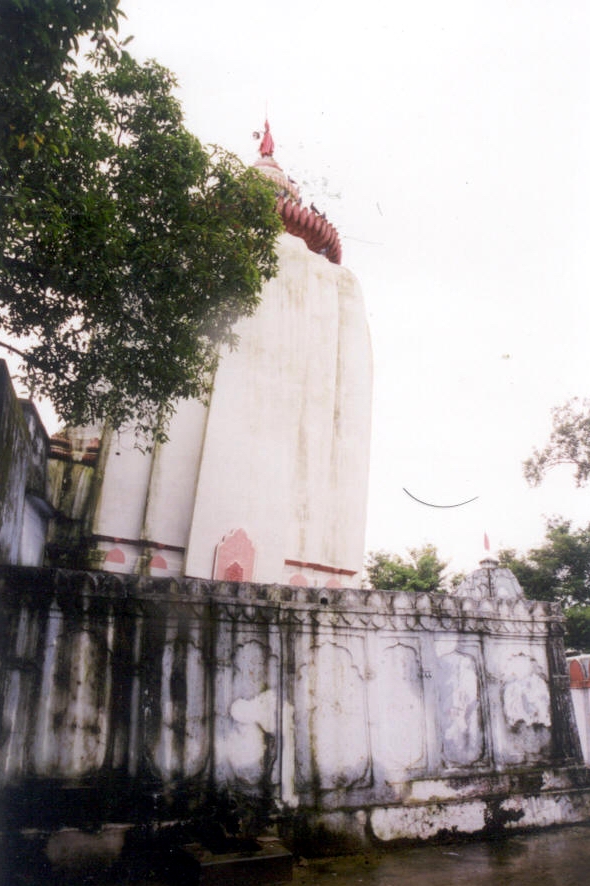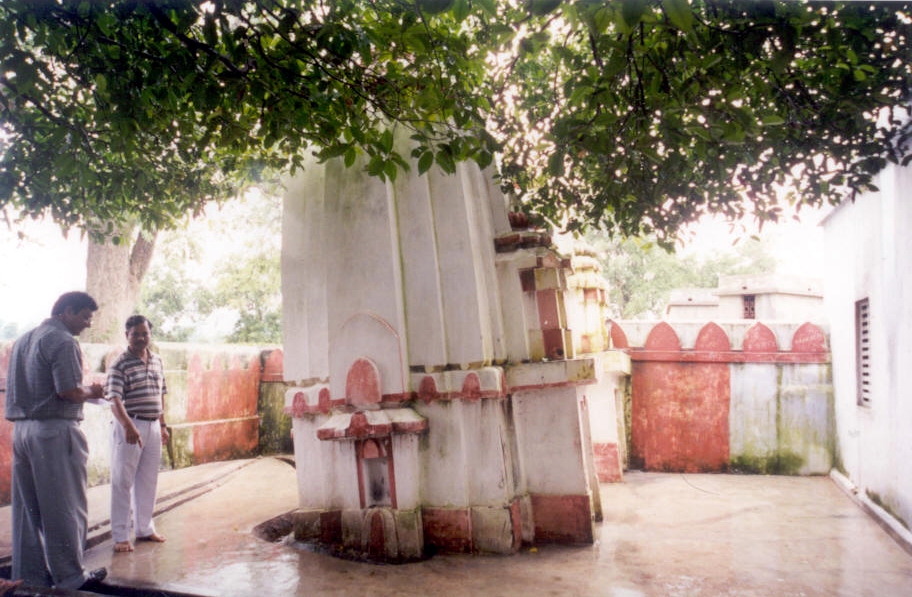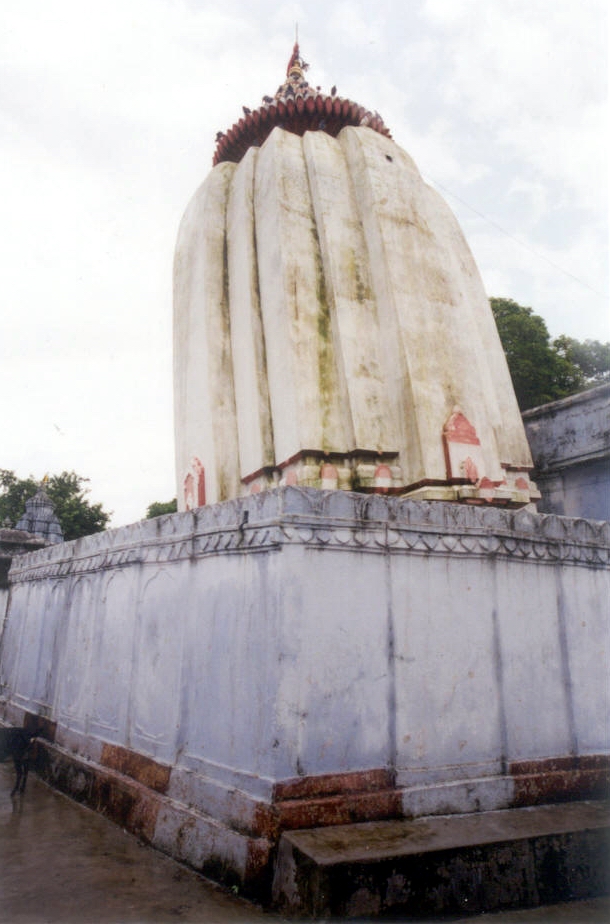 The
Leaning Temple of Huma.:
28 Kilometers East of Sambalpur, situated on the serene surrounding on the left
bank of river Mahanadi, the Leaning Temple of Huma the abode of Lord Vimaleswar
draws attention of several devotees, tourists, researchers and photographers all
around the world. The sylvan serenity, the unique piece of archaeological
monument, the melodious tenor of the crystal clear flowing water of the river
Mahanadi and the calmness of the place adds to its beauty. Thousands of
devotees gather every year on the sacred occasion of Mahashivaratri (in
the month of Fagun Kurshanapakhya chartudashi) The locality turns
into an area of bedlam and a place of commerce during the Mela. Chandan Jatra is
held (in the month of Baisakha Suklapakhya chaturdashi and Purnami).
The
Leaning Temple of Huma.:
28 Kilometers East of Sambalpur, situated on the serene surrounding on the left
bank of river Mahanadi, the Leaning Temple of Huma the abode of Lord Vimaleswar
draws attention of several devotees, tourists, researchers and photographers all
around the world. The sylvan serenity, the unique piece of archaeological
monument, the melodious tenor of the crystal clear flowing water of the river
Mahanadi and the calmness of the place adds to its beauty. Thousands of
devotees gather every year on the sacred occasion of Mahashivaratri (in
the month of Fagun Kurshanapakhya chartudashi) The locality turns
into an area of bedlam and a place of commerce during the Mela. Chandan Jatra is
held (in the month of Baisakha Suklapakhya chaturdashi and Purnami).
 Many
enigmatic stories, legends and mysteries are associated with regards the
construction of the temple. But what the unrecorded history tells, that the
temple was first constructed by the the Chowan king Balram Dev during the fifth
century BC and lfinally completed during 1617-1657 by Veer Baliyar Singh,
the king of Sambalpur. The king donated seven villages (Huma, Pulputunga,
Gangadharpali, Dhatukapali, Mahel and two other villages) to the Hota Brahmin
family of Papanga to serve the deity of Lord Mahadev. The domain of
Huma has a magnificent pictorial significance. Huma Province or the Estate of
Huma was a stretch from the River Ang to the River Mahanadi. Balaram Dev the 1st
King of Chauhan' dynasty had inherited this region. The kingdom of Bargarh was
the center of this province and a fort was built on the bank of the river Jeera.
The ruins still lay there as a witness to the past. The temple of Lord
Vimaleswar stands leaning there reminding of the glorious past of Sambalpur till
date.
Many
enigmatic stories, legends and mysteries are associated with regards the
construction of the temple. But what the unrecorded history tells, that the
temple was first constructed by the the Chowan king Balram Dev during the fifth
century BC and lfinally completed during 1617-1657 by Veer Baliyar Singh,
the king of Sambalpur. The king donated seven villages (Huma, Pulputunga,
Gangadharpali, Dhatukapali, Mahel and two other villages) to the Hota Brahmin
family of Papanga to serve the deity of Lord Mahadev. The domain of
Huma has a magnificent pictorial significance. Huma Province or the Estate of
Huma was a stretch from the River Ang to the River Mahanadi. Balaram Dev the 1st
King of Chauhan' dynasty had inherited this region. The kingdom of Bargarh was
the center of this province and a fort was built on the bank of the river Jeera.
The ruins still lay there as a witness to the past. The temple of Lord
Vimaleswar stands leaning there reminding of the glorious past of Sambalpur till
date.

The Temple: The temple of Lord Vimaleswar
is seen standing leaning to one side. The prominent deity of Vimaleswar is chief
of the deities among the 'Asta Sambhu'. (Kedarnath of Ambhavana,
Biswanath of Deogaon, Balunkeswar of Gaisama, Maneswar of Maneswar, Swapneswar
of Sorna, Bisweswara of Soranda and Nilakantheswar of Nilji are the Asta
Sambhus) As for the archaeological peculiarity of the temple, no satisfactory
research has been done. The expert say that the temple leans towards the
North-East direction at an angle of 5° to 6°, (form 90° vertical) supporting
corridors has been built around the fifteen feet tall temple, to shield it from
coming down.
There are two different versions regarding
the history or the temple's construction. The first one tells that king Ananga
Veema Deva III, who suffered from the virulent ailment of Tuberculosis erected
the temple as a measure to his remedy.
Receiving the divine direction the king
walked along the Mahanadi Bank and reached the sacred spot of Huma. There he
discovered a leaning `Shiva Lingam'. There the King decided to build a temple of
Lord Vimaleswar. He arranged the regular worship of the deity. He also got the
divine message that all structures to be constructed shall be found leaning. The
country folk of the neighbourhood villages believe that the temple was built by
Lord Viswakarma. It is also believed that a long portion of the `Lingam' lies
hidden under the earth.
Why the Temple Leans: Without any genuine
research, and historical certainty it is not possible to find the real grounds,
regarding the shape of the temple. However, some hearsay matters can be taken
into consideration. Some say soon after the construction of the temple was over,
there was an unanticipated thundering sound and the temple leans there after.
Other says that the pressure of the river current forced the temple to lean
towards North-East direction . The soil condition may also be another factor
behind the leaning structure. Amazingly, all other structures like the Bhairabi
Temple, Jagannath Temple, Aruna Stambha, the Kapileswar Temple etc., built later
also leaned to one side. The Machindra Ghat at the back side of the temple
provides a spectacular sight of Red Kudo fish that attracts a thousand of the
visitors. Every year in the Kartik -suklapakhya chaturdashi day the Ghatpuja is
observed at the Machindra Ghat. The Kudo fishs have different names, and they
are all called individually and offerings are offered.
This Monument is a proof to our glorious
past, it needs preservation, documentation and interpretation. Who has to come
forward to salvage the lost past of Mankind, is it you, is it us, now is the
time now or never.
Back to Top

 The
Leaning Temple of Huma.:
28 Kilometers East of Sambalpur, situated on the serene surrounding on the left
bank of river Mahanadi, the Leaning Temple of Huma the abode of Lord Vimaleswar
draws attention of several devotees, tourists, researchers and photographers all
around the world. The sylvan serenity, the unique piece of archaeological
monument, the melodious tenor of the crystal clear flowing water of the river
Mahanadi and the calmness of the place adds to its beauty. Thousands of
devotees gather every year on the sacred occasion of Mahashivaratri (in
the month of Fagun Kurshanapakhya chartudashi) The locality turns
into an area of bedlam and a place of commerce during the Mela. Chandan Jatra is
held (in the month of Baisakha Suklapakhya chaturdashi and Purnami).
The
Leaning Temple of Huma.:
28 Kilometers East of Sambalpur, situated on the serene surrounding on the left
bank of river Mahanadi, the Leaning Temple of Huma the abode of Lord Vimaleswar
draws attention of several devotees, tourists, researchers and photographers all
around the world. The sylvan serenity, the unique piece of archaeological
monument, the melodious tenor of the crystal clear flowing water of the river
Mahanadi and the calmness of the place adds to its beauty. Thousands of
devotees gather every year on the sacred occasion of Mahashivaratri (in
the month of Fagun Kurshanapakhya chartudashi) The locality turns
into an area of bedlam and a place of commerce during the Mela. Chandan Jatra is
held (in the month of Baisakha Suklapakhya chaturdashi and Purnami). Many
enigmatic stories, legends and mysteries are associated with regards the
construction of the temple. But what the unrecorded history tells, that the
temple was first constructed by the the Chowan king Balram Dev during the fifth
century BC and lfinally completed during 1617-1657 by Veer Baliyar Singh,
the king of Sambalpur. The king donated seven villages (Huma, Pulputunga,
Gangadharpali, Dhatukapali, Mahel and two other villages) to the Hota Brahmin
family of Papanga to serve the deity of Lord Mahadev. The domain of
Huma has a magnificent pictorial significance. Huma Province or the Estate of
Huma was a stretch from the River Ang to the River Mahanadi. Balaram Dev the 1st
King of Chauhan' dynasty had inherited this region. The kingdom of Bargarh was
the center of this province and a fort was built on the bank of the river Jeera.
The ruins still lay there as a witness to the past. The temple of Lord
Vimaleswar stands leaning there reminding of the glorious past of Sambalpur till
date.
Many
enigmatic stories, legends and mysteries are associated with regards the
construction of the temple. But what the unrecorded history tells, that the
temple was first constructed by the the Chowan king Balram Dev during the fifth
century BC and lfinally completed during 1617-1657 by Veer Baliyar Singh,
the king of Sambalpur. The king donated seven villages (Huma, Pulputunga,
Gangadharpali, Dhatukapali, Mahel and two other villages) to the Hota Brahmin
family of Papanga to serve the deity of Lord Mahadev. The domain of
Huma has a magnificent pictorial significance. Huma Province or the Estate of
Huma was a stretch from the River Ang to the River Mahanadi. Balaram Dev the 1st
King of Chauhan' dynasty had inherited this region. The kingdom of Bargarh was
the center of this province and a fort was built on the bank of the river Jeera.
The ruins still lay there as a witness to the past. The temple of Lord
Vimaleswar stands leaning there reminding of the glorious past of Sambalpur till
date.